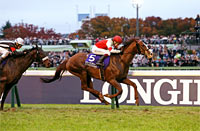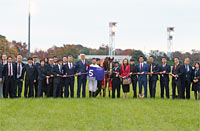Japan Cup (G1) - Comments from Japanese runners' connections

Almond Eye
Sakae Kunieda, trainer
“My expectations that she would be able to do well going straight from the Japanese Oaks to the Shuka Sho were met. She did seem a bit lightheaded after the race and she ran a temperature for a bit but quickly recovered. We’ve done what we always do between races, send her to Northern Farm Tenei. She came back to the training center on Nov. 8 and Christophe Lemaire rode her for morning work on Nov. 15. She looks leaner than she did before her last race as there has been less time between races, but she’s relaxed and her responses are good. She was even in racing shape last week. In the Japanese Oaks, she was a bit keen in places but, now that she’s matured, I think she’ll run more smoothly and more in tune with her rider. She’ll be up against colts and older horses but she’ll have the weight advantage and the change to a wide-open course will be a plus.” |
|

Cheval Grand
Yasuo Tomomichi, trainer
“He was a bit tense in the Kyoto Daishoten and I think that was why he couldn’t quicken as well as he should have been able to. He was in good shape and, just as he didn’t have the acceleration he needed in the same race the year before, he’s the type of horse that improves with a sharpener. He worked with two other horses on Nov. 15 over the woodchip course. Cristian Demuro rode and it was a good hard workout for one week out. He doesn’t have that great of a kick but he can run well over distance and I’m hoping he’ll get a trip that will allow him to use that to his advantage. I’m expecting him to improve and I think you can say that the Tokyo 2,400 is his best race. I’ve got my hopes pinned on seeing him change.” |
|

Ganko
Shohei Nakamura, assistant trainer
“In the Copa Republica Argentina last out, he was slow out of the gate and that hurt. The pace was slow and so everything came down to the late speed and he can’t run that kind of race. He came out of both his races this autumn fine, there’s been nothing out of the ordinary and he’s looking his usual self. Since there are only two full weeks in between races, he’s had pool work and we just breezed him last Friday. With a fast workout this week, that should be enough. If he had been able to race from a more forward position last time, I think he would have finished very close to the top finishers. I want him to start well and get a forward position. If he can run at his own pace, it’ll be interesting to see how well he does.” |
|

Happy Grin
Junji Tanaka, trainer
“I had been eyeing the Capital Stakes as well as the Japan Cup, but for a NAR-based horse there is no greater honor than to be able to run in the Japan Cup, so I decided to take on the challenge. In the Fuji Stakes last race, he drew wide, but I think if he hadn’t gone wide in the stretch he would have been able to gain a bit more ground. I don’t think the results reflected his ability. Looking at the strength of this field, the bar is very high, but by taking on this race, it could open up a whole new future for him. I’m hoping he’ll show us his best.” |
|

Kiseki
Yasuyuki Tsujino, assistant trainer
“He led in the Tenno Sho (Autumn) and it was a good race. I think he showed us a new side of himself. If you compare it to the spring, when he wasn’t true to form, you can see that he is squarely back on his feet. He doesn’t seem to have been the worse for wear and tear and he was quickly filled out nicely after that race. Last week, he worked on the flat over the course and we pushed him hard. He’s had two starts this autumn and he has stabilized both mentally and physically. It looks like he’ll maintain his condition and be able to take on this next race in good shape. There are no worries about the 2,400 meters and if another horse wants to lead, I think this one can hold back. He looks to be able to run his own race. I’m looking forward to it.” |
|

Mikki Swallow
Takanori Kikuzawa, trainer
“For the Osaka Hai this spring, he had been in good condition while at Miho, but the trip to Hanshin and the heat afterwards while stabled there took their toll. He was oddly quiet. But he did manage a fifth-place finish and did make an honest effort. Once over that, he was ready for the Sapporo Kinen but was under pressure coming out of the backstretch all the way into the top of the stretch and then didn’t get a clear run home. He took a while recovering from that last race. Last week (jockey) Norihiro Yokoyama rode him in the morning with him working in tandem. As of last week, he wasn’t in really great shape, but he has improved. It’ll be his first time racing to the left and from the looks of his morning training, I’d say there shouldn’t be a problem. I think his best is still to come but he has talent and I’m looking forward to seeing just how well he can do at this point.” |
|

Noble Mars
Hiroshi Miyamoto, trainer
“He was able to run his own race last out in the Copa Republica Argentina but the slow pace demanding a sharp kick in the final stage was hard on him. And I think that I got him ready a bit too quickly. He came out of that race well though and has handled all the work we’ve given him getting ready for this race. With only two full weeks between races, I had him work at a 15-15 pace on the weekend and with a bit of fast work this week, that should be sufficient. He did well at Tokyo in the spring, so if he can run at his own pace I’m looking forward to him being able to show us his tenacity. A slow pace like his last race will make it tough, so If possible I want there to be a decent pace.” |
|

Satono Crown
Kazutomo Mori, assistant trainer
“In the Takarazuka Kinen, he had gotten a good position midfield and was running well but at the point he needed to make his move, his responses were poor and he had nothing to give in the stretch. Having returned from Dubai was no doubt a factor, but we can’t say exactly what went wrong. He came back to the training center on Oct. 4 and we were getting him ready with an eye to the Tenno Sho (Autumn). But, he didn’t come along as we had hoped he would, his improvement was too slow and so we changed our sights to here. He has finally gotten back to where he used to be before a race. Since it has gotten colder now, we worked him hard last week. He’s a difficult horse and tends to get better results coming directly off a layoff, so I’ve got my hopes up there.” |
|

Satono Diamond
Yasutoshi Ikee, trainer
“The most important thing in the Kyoto Daishoten was that the jockey really did an excellent job. And he has also ridden him regularly in work and the horse’s hindquarters have really strengthened. His competitive spirit is nearly back to where it was in the best of times. I’d say the results he got were the result of everything coming together, the mental and physical. He’s lean looking and I would like his muscles to be a bit fuller. His muscle tone came out nicely after his last race, but he had gone into it in better shape too. On Nov. 15, (jockey) Joao Moreira rode him and he worked in tandem with another horse. I gave instructions to focus on the last furlong and the jockey said the horse’s balance was excellent. As of last week, he still had things to work on, but I think he has improved bit by bit. He no longer has problems with his breathing, his lungs are stronger and I don’t think the Tokyo 2,400 is that much of a minus.” |
|

Sounds of Earth (Yello cap)
Kenichi Fujioka, trainer
“Normally, I would have run him in the Kyoto Daishoten, but I now think he’s better suited to a shorter distance, so I ran him in the Mainichi Okan last out. But the times were fast with it being the first week of the race meeting and, though he did run well at the end, the frontrunners weren’t slowing. With that kind of race, he didn’t have a chance. He was fine after that race and last week he worked in tandem on the flat and his time was good. He’s always in form in the fall and doesn’t show any stiffness either. I think he’s almost as good as he was in his best times. Two years ago he ran second to Kitasan Black so I don’t think there’s any problems with the conditions. And I think he’s no worse than he was then. But we’ll have to see how age will figure in.” |
|

Suave Richard
Yasushi Shono, trainer
“He was late out of the gate in the Tenno Sho (Autumn) and then he got hit by the other horse coming out. But even so, he didn’t respond in the stretch. Maybe it was a mental thing. I just can’t say for sure. He didn’t have any damage from the race and he’s back in the same condition he was before that race and is handling all his training well. And the last race has toned him up. Since there’s little time between races, I had the jockey hold back and I think that it’s enough for now. He wasn’t able to meet expectations in the Tenno Sho (Autumn) but the lineup is strong and he definitely has power so the Tokyo 2,400 should not be a problem. He did have some issues with the gate, so I’ve schooled him in the gate. I think he should do well if he comes out of the gate well and can concentrate on his own running.” |
|

Win Tenderness
Haruki Sugiyama, trainer
“He took the lead last out in the Copa Republica Argentina but he was running rather leisurely. It all came down to the late speed and though he wasn’t able to pick it up enough to win, I think he did hold his ground well. Since then, he has recovered well and breezed on the weekend. With little time between races, there’s no need to push him too hard. I’ll fine-tune him this week and that should be enough. He doesn’t have to lead. He can watch what the others are doing and make his move. It’s a Grade 1 race and it won’t be easy, but the jockey knows the horse well. He’ll have to give it his all.” |
|
Sources: Keiba Book, Netkeiba
|

- Preview
- Barrier draw
- Past performances of runners

- News
- Race result
- Video
- 2020 English

- 2019 English

- 2018 English

- 2017 English

- 2016 English

- 2015 English

- 2014 English

- 2013 English

- Photo Gallery
2020 Winner: Almond Eye



2019 Winner: Suave Richard


|





